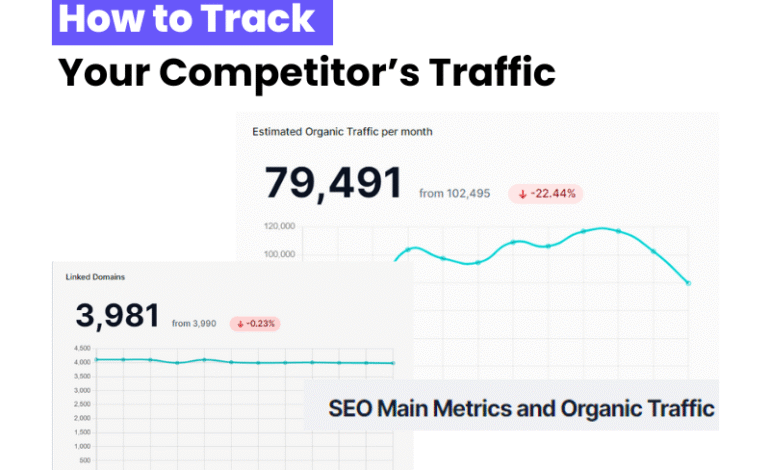How to know where your competitors’ traffic is coming from

Did you know that you can know where your competitors’ traffic is coming from? One of the most important points to consider when making a digital marketing strategy is to analyze your rivals.
In this small guide, I am going to reveal one of the most effective practices to spy on your competitors and be able to find out some of their best content strategies.
You will be able to see what the main sources of traffic are for any website and see which keywords they havewell-positionedd. You will uncover anyone’s content strategy, and you will be able to improve it toattracte a good handful of new visitors yourself.
To do this, we will use several tools, some paid and others free, which will become essential when analyzing your competition.
Types of Traffic Sources
Before you start, the first thing you need to know is the different traffic sources that exist. There are 5:
- Organic: These are those that come from search engines such as Google. This type of user is the one who types a keyword into the search engine and clicks on one of the results that appear.
- Social: These are the visits that come from social networks.
- Direct: This is the part of users who arrive at your website by typing the name of your domain in their browser. They are also the ones who have your website saved in favorites.
- Referrer: Those visits that come from links from other websites.
- Other: They are those that cannot be classified in any of the 4 previous divisions.
It is best to have your volume of visits distributed among the 5 sources, although the most common is to have them distributed between Organic, Social, and Referral. Keep in mind that if you only have visits focused on a single channel, if you ever have a problem with it, your total traffic will plummet.
Remember that to see where your website visitors are coming from, you need to install Google Analytics.
How to Know Where Your Competitor’s Traffic Is Coming From: Sources
To find out where your competitors’ traffic is coming from, the best free tool for this is Similarweb.
This online tool will allow you to know an estimate of the total traffic of the website under analysis, its main sources of traffic, the average duration of visits, the bounce rate, and much more.
However, you should know that the data provided by this website is approximate, so you should not look too much at the numbers.
Go to Similarweb, type in the domain of the website you want to analyze, and hit the Start button.
A report will appear with a lot of information. Scroll down and find the “Traffic Sources” section, where you can see a bar graph with an estimate of the traffic from each source.
To see the reliability of the tool in terms of the estimated percentages, I leave you with a comparison obtained by comparing the results of Google Analytics of a client’s website and those obtained by Similarweb:
As you can see, in this case, they are quite similar and are enough to get an idea.
With this data, you can see if they’re exploiting a particular channel a lot and find out what they’re doing to make them do so well. In this way, you can take each opponent’s best strategy and replicate it by adding your brand touch.
For example, imagine that you analyze a website whose visits come mostly from the referral source, and your website hardly gets visits of this type. This source is very important for SEO since Google understands a link as a recommendation. With this information, you already know that the web is rich in links, so you can use a link analysis tool to find out where they come from and try to replicate them.
Without a doubt, this is one of the link-building strategies to get quality backlinks.
How to Know Where Your Competitor’s SEO Traffic Is Coming From with SEMRush
Knowing the visitor profile of a website is interesting, but knowing exactly which keywords are working for your competitors and how much organic traffic they get with each of them is very interesting. Keep in mind that with this information, you will be able to attack the same keywords that are driving a lot of traffic to your competitors. In this way, in addition to extracting keywords through initial Keyword Research, you will get more ideas to create more content.
To do this, go to SEMRush and go to the Domain Analysis section > Overview. There, you have to enter the domain in the search engine and click on the “Search” button.
The tool will show you a report with a lot of information about the analyzed website, such as the estimate of SEO traffic, paid traffic, number of links, main competitors, and, most importantly for this guide, the main keywords for which that site receives organic visits.
As you only get a summary, locate the “Best organic words” section, click on “View full report,” and a table will appear showing a lot of data. For our analysis, the most important columns on which you should focus your attention are these:
- Keyword: It is the keyword that people who have finally landed on the competitor’s website have typed into Google.
- Pos: This is the position that the competitor has in the list of results with that specific keyword.
- Volume: It is the number of searches that the keyword has in Google. That is, the number of times users have typed that keyword into the search engine each month.
- URL: Here’s the URL your competition uses for that keyword. This is the link that appears in the list of results for that specific keyword.
- Traffic, %: Here, SEMRush gives you the percentage of visits that represent those keywords of the total traffic of the analyzed website.
- KD: It is the degree of difficulty that a keyword has. The higher it is, the harder it will be to position yourself for it.
By viewing this report, you will be able to know the keywords that benefit them the most, where they are in the results list, the monthly volume of searches they have, the URL of the landing page, and the percentage of your total competitor’s traffic that each keyword represents.
Normally, web pages have a series of 3 or 4 dominant keywords that attract a good percentage of organic visits and then a very atomized list.
In addition, as if that were not enough, the tool also provides us with a difficulty value (KD) that will help you get an idea of how difficult it will be to place your website in the top positions. However, it is not equally difficult for everyone to position themselves in Google results, so now that you know where your competition’s traffic comes from, it remains to be seen if you will be able to overcome it.
To find out, just follow the following 3 steps:
1) Judge your rivals’ on-page SEO
In addition to showing you the necessary information to know where your competitor’s traffic is coming from, SEMRush also provides you with the exact URL that your rival is using to position that specific keyword.
One of the indicators to know if you will be able to beat them is to enter their pages and see how SEO optimization is carried out.
Let’s go with an example.
Imagine that you have a film blog and you want to know where your competitors’ traffic is coming from and see if it will be possible for you to beat them. You go to SEMRush and it tells you that “best movies 2017” is the keyword that brings a good percentage of its visits to that blog.
This is an interesting piece of information as it gives you ideas of the content that users want to read while also telling you the exact keyword that you can use on your website to get a piece of that pie.
To see if your content is optimized, go to the landing page that the blog uses for that keyword and see if “best movies 2017” is in the title, in the H1, H2, in the URL slug, in the body of the content, and in the alt attribute of the images.
If you see that the article has not been fully optimized, it is a good opportunity for you to make more optimized content for that keyword and of better quality so that Google will take you into account.
2) Compare Domain Authority
Another factor to take into account to know if it will be possible for you to rank for a specific keyword is to compare the domain authority.
In case you didn’t know, all domains have a relevance/strength on the internet that is based on their age, the number of quality inbound links, loading speed, and On-Page SEO optimization, among many other factors. This is what is commonly called DA or domain authority.
With this value, you will be able to find out at a glance how strong a website is and, therefore, you will be able to compare it with yours and see if it is an affordable keyword or, on the contrary, you should bet on another.
To find out the domain authority of a website, just download the Moz toolbar and visit the websites you want to analyze.
If your DA is very far from that of your competitors, I advise you not to try to rank that keyword unless your rivals’ content does not have optimized On-Page SEO or good links.
3) Research the link profile
The third indicator that can help you when it comes to seeing if it is possible to rank for a specific keyword is the number of quality links that the rival landing page has.
The number of quality inbound links that a particular page has is very important when Google decides which to put first.
To find out if a particular page has good links, I recommend using OpenLinkProfiler. It is a paid tool but it has a free version that can be used for basic analysis.
To begin the analysis, take the URL of the page you want to outperform and enter it into the tool.
You will see a list of all the links pointing to that page and the anchor text that those backlinks have. If you see that it barely has quality links and the anchor text does not contain the keyword, it will be a good sign and will allow you to have good options for positioning.
I hope you found this post on how to know where your competitors’ traffic is coming from interesting and useful.
As you have seen, in addition to the typical Keyword Research, it is very useful to know what keywords your competition is positioning in order to take a good handful of visits directly from them.
If you have any questions, I’ll be happy to answer them in the comments as soon as possible about everything related to your competitor’s traffic.










